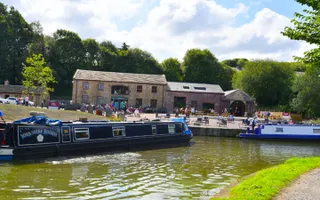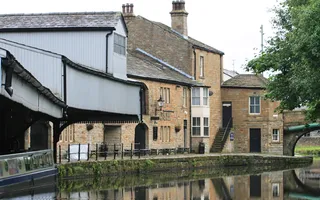Burnley was once cotton-weaving capital of the world, and you can almost imagine the clickety-clack of a staggering 79,000 looms in what is now called the Weavers' Triangle. This walk treads in the footsteps of the Industrial Revolution in one of its best surviving industrial landscapes. Historic buildings wrap around the canal – weaving sheds, spinning mills, engine houses, warehouses and workers' homes – reminders of Burnley's magnificent weaving heritage. And to top off this lock-free stretch of the Leeds & Liverpool Canal, you'll walk along Burnley Embankment, one of the wonders of the waterways.
Canal walk in Burnley
Enjoy this 1.5 mile walk along the Leeds & Liverpool Canal in the historic town of Burnley.

Canal: Leeds & Liverpool Canal
Start: Mitre Bridge OS Grid ref: SD832327 Postcode: BB11 1SD
Finish: Godley Bridge OS Grid ref: SD846331 Postcode: BB11 3QW
Distance: 2.5km / 1.5 miles
Route instructions
Start: Come down to the canal from Mitre Bridge and turn left to follow the towpath under the bridge.
1. Former warehouses, chimneys, weaving sheds, ‘north light' roofs, engine houses & spinning mills line the banks of the canal. Bulging with heritage, many of the warehouses and other buildings are now Grade II-listed. Victoria Mill is now part of the Burnley Campus of the University of Central Lancashire.
2. A contemporary rust-clad and glass footbridge across the canal marks your arrival at Sandygate Square. This modern development includes deep steps creating a canalside amphitheatre and terrace. Behind the amphitheatre are student halls of residence, again part of the Burnley Campus. Looking down Wiseman Street from the bridge, you can see the tallest mill chimney still standing in Burnley at Oakmount Mill. It began life as a spinning mill in the 1830s and was still producing cotton up to 1979. It is possible to see the original mill engine in action a couple of times a year.
3. Across the canal is the beautifully restored chimney and row of terraced houses called Slater Terrace, now Grade II-listed. George Slater owned and ran three mills in the 1800s, employing over 300 people. He built Slater Terrace for his workers, unusually right above the canalside warehouse.

4. As you walk under Sandygate Bridge, the views open up across the mill chimneys and rooftops towards the hills beyond as the canal meanders past more warehouses. By the edge of the towpath sits a ‘½'-mile milepost. Mileposts were required to tell working boatmen the distances they'd travelled and therefore how much toll would be due to canal companies who charged on a ton and mile basis. Leeds & Liverpool Canal Company marked every ¼, ½, ¾ and mile along the canal, or the distance from both Leeds and Liverpool. Many have now been restored or replaced thanks to special funding for the canal's 200th anniversary in 2016.
5. The canal is enclosed by warehouses as you approach Burnley Wharf. A canopy, supported by cast-iron beams and columns, overhangs the canal and would have provided shelter for boats loading and unloading here. Unfortunately the pub which once occupied one of the canalside warehouses has closed down.
6. The Visitor Centre and museum is in the former wharf master's house and toll office, where working boats would have paid tolls for transporting goods such as cotton and coal along the Leeds & Liverpool Canal here. Exhibitions tell the story of Burnley & its weaving heritage, and it is possible for you to try some weaving.

7. Finsley Gate Wharf is on the bend in the canal as it turns sharply into the Burnley Embankment. Dating from 1784, and once a busy workplace for blacksmiths, forgers, boat builders, farriers and later carpenters, the Wharf and its now Grade II-listed buildings have been restored into a canalside heritage hub including a forge, guesthouse, café and restaurant.
8. One of the engineering wonders of the waterways, Burnley Embankment carries the Leeds & Liverpool Canal over the rooftops of Burnley, and has two aqueducts, over the River Calder and a main road. Known as the 'straight mile', it is ¾ mile long and its construction in 1795 meant that boats could cross the valley without the need for a set of locks at either end. At 60ft high, the view over row after row of 19th-century terraced houses to the hills beyond is spectacular.
End: Thompson Park makes the perfect spot for a break before you hop on a bus or retrace your steps along the towpath to Mitre Bridge, enjoying this walk from a different perspective.

Last Edited: 8 May 2024


Stay connected
Sign up to our newsletter and discover how we protect canals and help nature thrive


